
views
Get in a positive mindset before driving.

Try meditation and repeat calming affirmations as you get ready to drive. Do mindfulness exercises, like timed breathing or stretching, before getting in the car. You could even watch an episode of your favorite TV show or listen to a calming, meditative playlist of songs or ambient sound effects. Try to set aside 10 or 20 minutes each day to practice your techniques. Visualize yourself arriving safely. Before you set off, it may help to picture yourself arriving at your destination, safe, calm, and happy. Food can also help calm you down; consider grabbing a snack and a glass of water before you hit the road.
Make yourself comfortable in the driver's seat.
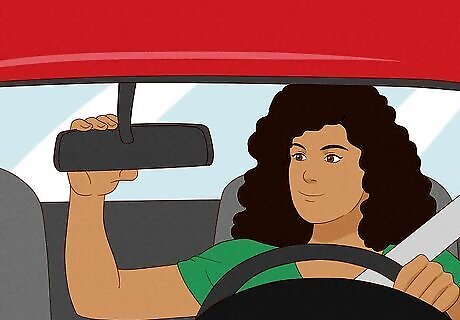
Being physically comfortable reduces your stress and helps you focus. Adjust the seat and mirrors as needed; from the seat, you should be able to easily grip the steering wheel and touch the pedals with your feet. Clear out any trash or clutter around you, especially on the floor near the pedals. Finally, hang a car diffuser with essential oils in the car to ease anxiety. Do a quick rundown of all the buttons and levers in the car. Make sure you know what each one does and how to use them before you start driving.
Learn where all essential documents are.
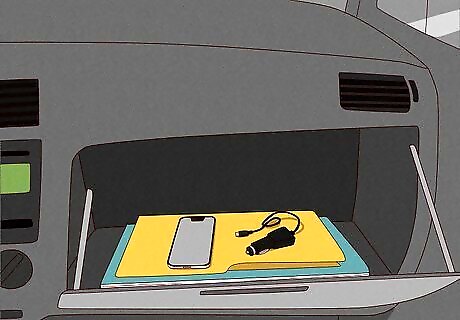
Be prepared for anything before you start driving on your own! Have your parent (or the car owner) show you where to find the vehicle registration and insurance cards and a list of phone numbers, including roadside assistance and emergency contacts. That way, you'll know what to do if you encounter trouble on the road. Bring a cell phone and charger with you so that you'll always have the option to ask for help if you need it.
Plan out your route before you leave.
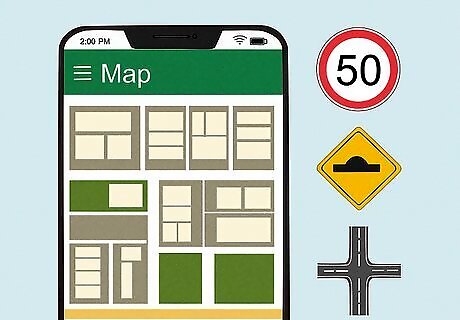
Take note of the route's traffic levels and speed limits beforehand. Look up your destination ahead of the drive and the steps to get there, so you're not relying on GPS as you go, especially in an unfamiliar area. Keep track of streets and intersections, so you know which signs to look for and won't have to worry about missing any of your exits or turns. It's also a good idea to pick out any parking lots or rest stops along the route so you have a place to pull over if you get stressed.
Practice driving in an empty parking lot.
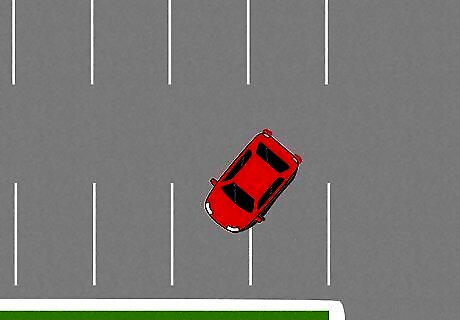
Learn your way around a car with no extra pressure. You won't have to worry about traffic laws and other drivers in a parking lot. Practice basic maneuvers like starting, stopping, turning, and signaling in a quiet, safe place. Parking lots also allow new drivers to practice driving at different speeds since there is more room to cruise around than a driveway. Tackle driving maneuvers that seem especially daunting or stressful. For example, many teens worry about parallel parking, but you can learn how to parallel park safely in an empty lot.
Drive on safe, slow roads.
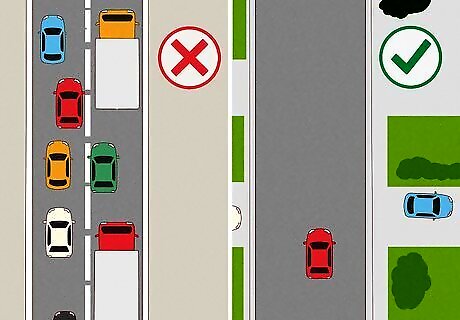
Pick a quiet area with low traffic to drive on roads comfortably. Once you've mastered parking lots, the next step is driving in residential or rural areas with fewer cars and having people walking around. This allows you to get comfortable driving on an actual road without worrying about causing an accident. Use the practice to apply road rules like signaling to other drivers and looking for speed limits. Practicing on a quiet road first means there is less pressure on you to get all the rules of the road right the first time around, and you won't have to worry about slowing down other drivers behind you.
Gradually expand your practice area.
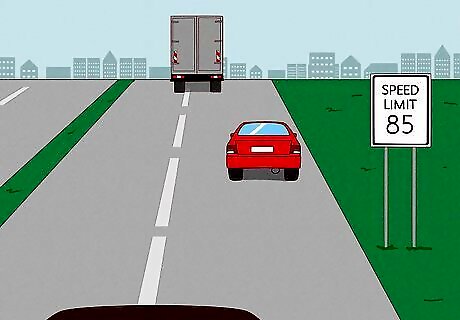
Get comfortable with different roads and speed limits. Once you feel comfortable driving on low-stress roads near your house, slowly get out of your comfort zone. You might start by driving on the main road with a parent. Then, try driving on that same road without a parent (if you have your license). Eventually, you should work up to higher stress situations, like driving on the highway. Try challenging yourself with new routes when you feel comfortable. Take a different route to school, or drive with your parent to a different grocery store than you usually visit.
Practice in different weather and visibility conditions.
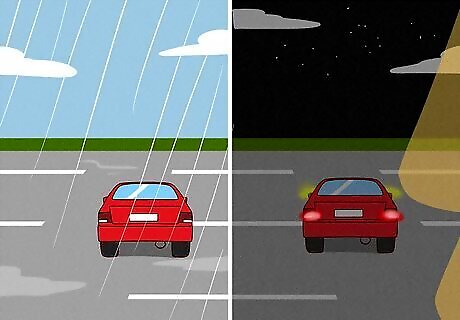
Learn to drive at night, in the rain, and even in the snow. Before traveling long distances in bad weather, take advantage of the rain or snow to practice for shorter distances, such as driving around your neighborhood. Practice night driving in safer areas (such as a slow road or parking lot) to help you get used to those new conditions as well. Rain, ice, and packed snow cause roads to be slippery, so learn to slow your speed and navigate roads safely. Night driving also requires you to pay extra attention to how you use your headlights and look more carefully for pedestrians, bicyclists, and other drivers. Remember, don't rush the process. While getting out of your comfort zone is necessary to overcome your driving anxiety, avoid entering situations that you're unprepared for.
Take deep breaths when you feel anxious.
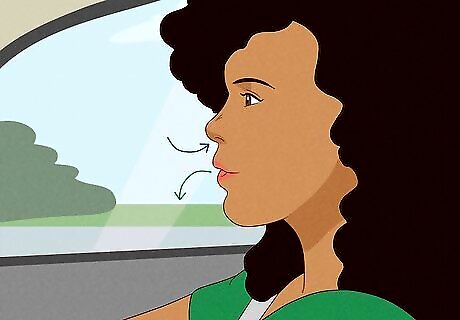
Breathing techniques help you release tension while driving. Sit comfortably with your back straight and breathe in through your nose, then out through your mouth. Try to breathe into your stomach rather than your chest. Continue breathing until you feel your anxiety fade, and take deep enough breaths that your lower abdomen rises and falls as you do so.
Get rid of distractions.
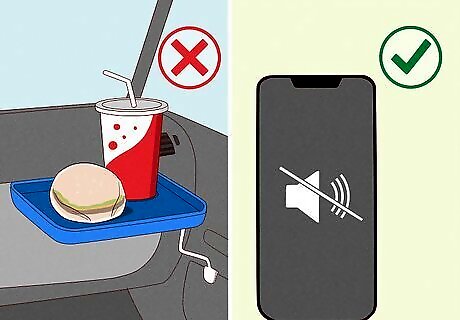
Distractions like food, phones, and the radio make anxiety worse. Keep your phone on silent and only use it when you're safely parked or have a hands-free setup to use it as a GPS. While listening to music can be calming, it's better to drive in silence until you feel comfortable on the road, so you pay more attention to your surroundings and other cars. Remember: your focus should be on the road at all times! Make sure you get between 8 to 10 hours of sleep each night! A good night's sleep will improve your focus; conversely, it'll be hard to concentrate if you're sleepy.
Pull the car over if you need a break.
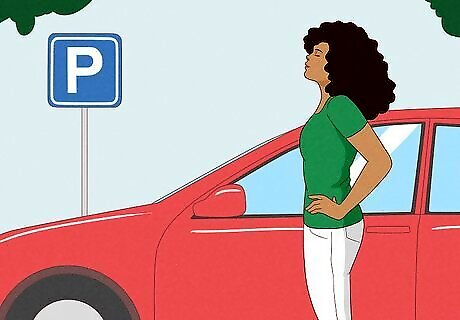
Find a safe place to park and take some time to calm your anxiety. Remember that there's nothing wrong with pressing the pause button if you feel overwhelmed! Practice the relaxation techniques you've learned, and take a few deep breaths. If you can, get out of the car and walk around in the fresh air. Continue driving when the anxiety subsides, and you feel ready. Try to avoid pulling over near busy streets or isolated areas. A populated but traffic-free street or parking lot is the best place to stop for some air.
Read through the driver safety manual.
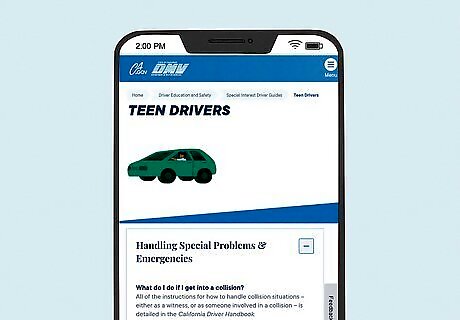
You'll feel more confident if you know the rules of the road. Once you read the manual, you'll pay more attention to the signs and markings on roads once you start driving. Test yourself on the different rules and regulations, so you feel safer interacting with other drivers on the road. You can find most driver's manuals on the DMV's website or at the office that issued your permit or license. You don't have to memorize the entire manual. However, you should be familiar with the basic road rules—it'll help you feel less anxious behind the wheel.
Take lessons with a driving instructor.
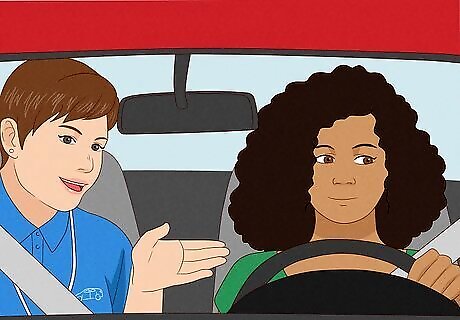
A driving instructor can show you the ropes and calm your anxiety. Enroll in a Driver’s Ed class through your school or a state-licensed driving program. Driving instructors give you in-depth lessons and help you identify and correct bad driving habits in a safe environment. You'll improve your skill with the help of a professional—and odds are their presence will make you feel more secure as you drive. Even if you know most of the basics of driving, an instructor can train you in areas that might be causing the most anxiety, like parallel parking or merging. A crash course or an intensive driving course is great if you need a confidence boost right before your driving test. These courses pack a ton of information and practice into a short period.
Discuss your feelings with a parent or guardian.

Before getting on the road, make sure someone knows how you feel. Your parent or guardian may not even know that you're avoiding driving because it makes you anxious! Talk to them about your anxieties and why you think you're experiencing them. A trusted adult may have advice or insight to ease your mind—and at the very least, they can teach you to drive while conscious of the fact that you have anxiety. You don't have to talk to your parent if you'd be more comfortable with someone else. This person could be another adult relative, a school counselor, or a friend's parent that you trust.
See a therapist if your anxiety persists.

Driving phobia can be treated with cognitive behavioral therapy (CBT). CBT gives you a space to imagine and walk through driving situations that trigger anxiety or fear. By preparing for the anxiety-provoking situation before it occurs, you'll be better prepared once it happens. A therapist will listen to your worries and provide you with techniques to help keep you calm and in control. Driving phobia often arises following an accident, characterized by intense fear and avoidance of driving that interferes with daily functioning. If you have your license but are too afraid to drive to school, you may have a driving phobia.

















Comments
0 comment